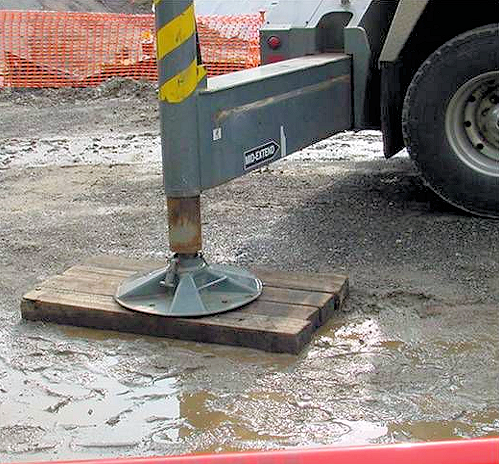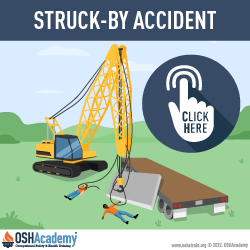Protecting Yourself from Struck-by Hazards
Heavy Equipment - Cranes, Excavators, etc.
There are a number important actions the employer must take to ensure your safety while working around heavy equipment on the worksite.
Below is a list of employer actions and a summary of a real-world accident.
- Determine if the ground is sufficiently level and firm to support the anticipated weight of hoisting equipment and associated loads.
- Assess hazards within the work zone that would affect the safe operation of hoisting equipment such as, power lines and objects or personnel that would be within the swing radius of the hoisting equipment.
- Erect barriers to mark the area covered by the rotating superstructure to warn workers of the danger zone.
- Ensure equipment is in safe operating condition via required inspections.
- Comply with all manufacturer procedures regarding proper operational functions of equipment, including its use with attachments.
- Ensure safe attachment of rigging devices such as shackles, hooks, eyebolts, spreader beams and slings, wedge socket and wire rope clips.
- Provide seatbelts while operating vehicles when required;
- Ensure roadways and grades are maintained to accommodate the safe movement of equipment.
- Ensure all earthmoving/compacting equipment with obstructed view does not operate in reverse gear unless the equipment has a reverse signal alarm, or a worker has been designated to signal when it is safe.
Description of Accident
A crew of ironworkers and a crane operator were unloading a 20-ton steel slab from a low-boy trailer using a 50-ton crawler crane with 90-foot lattice boom. The operator was inexperienced on this crane and did not know the length of the boom. Further, no one had determined the load radius. During lifting, the load moved forward and to the right, placing a twisting force on the boom.
The boom twisted under the load, swinging down, under and to the right.
Two employees standing 30 feet away apparently saw the boom begin to swing and ran. The boom struck one of the employees - an ironworker - on the head, causing instant death. Wire rope struck the other causing internal injuries. He died two hours later at a local hospital.
What would you recommend?
Recommendations
- train and test operators to determine qualifications - 29 CFR 1926.21(b)(2), 29 CFR 1926.1427, and ANSI B30.5 5-3.1.2
- require proper written procedures to ensure the method for lifting is within manufacturer's specifications - 29 CFR 1926.1417
To learn more about cranes and rigging safety see OSHAcademy courses 820 Cranes and Derricks Safety I and 821 Cranes and Derricks Safety II.
Knowledge Check Choose the best answer for the question.
2-1. What action should the employer take to protect workers when a crane with a rotating superstructure is operating on the worksite?
You forgot to answer the question!


